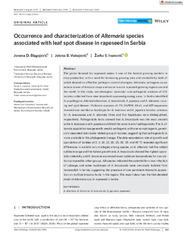Приказ основних података о документу
Occurrence and characterization of Alternaria species associated with leaf spot disease in rapeseed in Serbia
| dc.creator | Blagojević, Jovana | |
| dc.creator | Vukojevic, Jelena | |
| dc.creator | Ivanović, Žarko | |
| dc.date.accessioned | 2023-07-15T08:58:04Z | |
| dc.date.available | 2023-07-15T08:58:04Z | |
| dc.date.issued | 2020 | |
| dc.identifier.issn | 0032-0862 | |
| dc.identifier.issn | 1365-3059 | |
| dc.identifier.uri | https://plantarum.izbis.bg.ac.rs/handle/123456789/750 | |
| dc.description.abstract | The global demand for rapeseed makes it one of the fastest growing markets in crop production, with a need for increasing growing area and productivity, both of which depend on effective pathogen control strategies. Alternaria pathogens cause serious losses of brassica crops and occur in most rapeseed-growing regions around the world. In this study, morphological, molecular, and pathogenic analyses of 113 isolates collected from nine important rapeseed-growing areas in Serbia identified four pathogens: Alternaria brassicae, A. brassicicola, A. japonica, and A. alternata, causing leaf spot disease. Molecular analyses of ITS, GAPDH, Alt a1, and ATP sequences revealed one multilocus haplotype for A. brassicae and A. japonica isolates, whereas for A. brassicicola and A. alternata three and five haplotypes were distinguished, respectively. Pathogenicity tests showed that A. brassicicola was the most virulent while A. brassicae and A. japonica exhibited the same level of pathogenicity. The A. alternata population was generally weakly pathogenic with one nonpathogenic, genetically separated but closely related group of isolates, suggesting that pathogenicity is more unstable in this phylogenetic lineage. The data recorded on rate of growth and sporulation of isolates at 0, 5, 10, 15, 20, 25, 30, 35, and 40 °C revealed significant differences in evolutionary strategies among species, as A. alternata had the widest optimum range and the fastest growth rate, A. brassicicola showed the highest sporulation intensity, and A. brassicae expressed lower optimum temperatures for sporulation compared to other groups. All species indicated the potential for cross-infection of cabbage, and some haplotypes of A. brassicicola were previously isolated from horseradish in Serbia, suggesting the presence of one persistent Alternaria population on multiple brassica hosts in the region. This report describes the first detailed study of Alternaria spp. in rapeseed in Serbia. | sr |
| dc.language.iso | en | sr |
| dc.publisher | British Society for Plant Pathology | sr |
| dc.relation | info:eu-repo/grantAgreement/MESTD/Technological Development (TD or TR)/31018/RS// | sr |
| dc.rights | openAccess | sr |
| dc.rights.uri | https://creativecommons.org/licenses/by/4.0/ | |
| dc.source | Plant Pathology | sr |
| dc.subject | A. alternata | sr |
| dc.subject | A. brassicae | sr |
| dc.subject | A. brassicicola | sr |
| dc.subject | A. japonica | sr |
| dc.subject | rapeseed | sr |
| dc.title | Occurrence and characterization of Alternaria species associated with leaf spot disease in rapeseed in Serbia | sr |
| dc.type | article | sr |
| dc.rights.license | BY | sr |
| dc.citation.epage | 900 | |
| dc.citation.issue | 5 | |
| dc.citation.rank | M21 | |
| dc.citation.spage | 883 | |
| dc.citation.volume | 69 | |
| dc.type.version | publishedVersion | sr |
| dc.identifier.doi | 10.1111/ppa.13168 | |
| dc.identifier.fulltext | http://plantarum.izbis.bg.ac.rs/bitstream/id/2966/bitstream_2966.pdf | |
| dc.identifier.scopus | 2-s2.0-85082134218 | |
| dc.identifier.wos | 000529871200008 |


